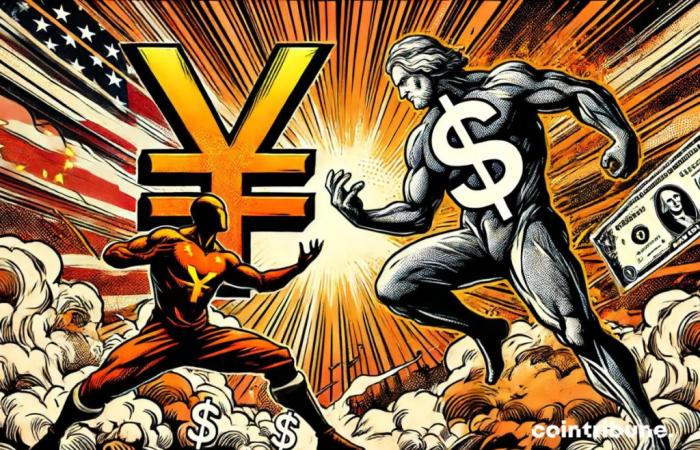9:00 a.m. ▪
4
min reading ▪ by
Luc Jose A.
The Chinese yuan has been trying for years to dethrone the US dollar as the world’s reserve currency. Despite a rise in power and constant efforts, the Chinese currency has not yet succeeded in supplanting the greenback. While dedollarization is gaining ground, the yuan is struggling to establish itself as a credible alternative.
The rise of the yuan and global dedollarization
For more than ten years, the Chinese yuan has tried to establish itself against the American dollar as the world’s reserve currency. Despite China’s continued efforts, the currency still remains far behind its American rival. The situation seemed to change with the rise of the global trend towards dedollarization. Indeed, many countries, particularly developing ones, are seeking to reduce their dependence on the dollar by promoting transactions in local currencies. This dynamic offers the yuan an unprecedented opportunity to position itself as a credible alternative to the dollar.
The implications of this trend are significant. By reducing their use of the dollar, these countries hope to strengthen their economic sovereignty and minimize the impact of fluctuations in the American currency on their economies. However, despite these potential advantages, the yuan is still struggling to convince due to various structural and economic obstacles.
Obstacles encountered by the Chinese yuan
According to James Steel, chief commodities analyst at HSBC Securities, the Chinese yuan has failed to eclipse the US dollar despite China’s numerous attempts to strengthen its currency. The expert points out that although central banks in developing countries are gradually getting rid of their US dollar reserves to buy gold, this strategy has not been enough to weaken the dominant position of the dollar. Efforts to marginalize the dollar on the global stage have encountered limits, as the yuan does not yet enjoy the confidence and stability needed to replace the greenback.
James Steel adds that even as central banks try to diversify their reserves, they remain dependent on the US dollar. The global value of the yuan is still insufficient to guarantee a complete transition. Furthermore, central banks often find themselves having to choose between limited alternatives, such as the euro or the yen, which do not offer the same advantages as the dollar.
This reality highlights the difficulty of reducing the dominance of the dollar, despite Chinese ambitions and dedollarization trends. Ultimately, the US dollar remains a key pillar of global monetary reserves, and the yuan, despite its advances, remains an emerging competitor rather than a true challenger.
Maximize your Cointribune experience with our ‘Read to Earn’ program! For every article you read, earn points and access exclusive rewards. Sign up now and start earning benefits.
Click here to join ‘Read to Earn’ and turn your passion for crypto into rewards!
Luc Jose A.
A graduate of Sciences Po Toulouse and holder of a blockchain consultant certification issued by Alyra, I joined the Cointribune adventure in 2019. Convinced of the potential of blockchain to transform many sectors of the economy, I took the commitment to raise awareness and inform the general public about this constantly evolving ecosystem. My goal is to enable everyone to better understand blockchain and seize the opportunities it offers. I strive every day to provide an objective analysis of current events, to decipher market trends, to relay the latest technological innovations and to put into perspective the economic and societal issues of this ongoing revolution.






